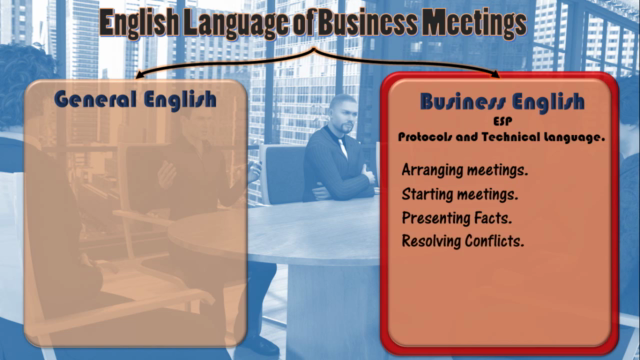360 useful English phrases for business meetings
Learn more than 360 phrases you can use in more than 50 different situation in business meeting and everyday situations.

What you will learn
1. Professionally use a variety of English phrases used in more than 50 everyday different situations especially at your workplace.
2. Practice the polite language used in business to communicate with people.
3. All the actors are native speakers so you can listen to the correct pronunciation of all words and phrases that are included in the course.
4. Have many alternative phrases for the same situation rather than only one phrase to use.
5. Have self-confidence when participating in a business meetings in English.
Why take this course?
The course is based on a simple English conversation in a business meeting.
In 51 short lessons we will be discussing the English used in different parts of the meeting.
Each lesson is a short video between 2 to 4 minutes (rarely longer than 4 minutes),
- Quotation from a part of the meeting conversation.
- Discussing the situational english used in this part of the meeting.
- About 6 to 12 different examples of English phrases related to the discussed situation that you can use right away in your meeting, job and life.
Here is a list of what you will learn:
Chapter 1: Situations related to Opinions (Part 1):
- Seeking opinions of all participants of the meeting. (8 Phrases).
- Seeking the opinion of just one person. (8 Phrases).
- Giving an opinion that is neutral (10 Phrases).
- Asking for opinions from different angles (3 Phrases)
- Giving a tentative opinion (7 Phrases).
- Giving a strong opinion (8 Phrases).
Chapter 2: Situations related to agreement and disagreement opinions:
- Strong Agreement (11 Phrases).
- Moderate agreement with someone’s opinion (10 Phrases).
- Tentative or partial agreement when you are not sure (5 Phrases).
- Strong Disagreement (14 Phrases).
- Moderate Disagreement (8 Phrases).
- Agreement using the word “especially” (3 Phrases).
- Agreement using the words “all, whole, entire, each and every” (4 Phrases).
- Using “so do I” to express agreement (6 Phrases).
- Disagreement using the word “but” (7 Phrases).
- Other indirect means of expressing disagreement with someone’s opinion (8 Phrases).
Chapter 3: situations related to Suggestions:
- Asking all participants for their suggestions to solve a problem (12 Phrases).
- Giving suggestions (8 Phrases).
- Rejecting a suggestion or expressing disagreement in a diplomatic way (4 Phrases).
- Expressing disagreement by casting doubt on an idea (6 Phrases).
- Direct disagreement with a suggestion (5 Phrases).
- Strong informal disagreement with a suggestion (5 Phrases).
- Offering alternative suggestions (12 Phrases).
- Soliciting for alternative suggestions to a rejected one. (5 Phrases).
- Praising others’ ideas (8 Phrases).
- Agreeing with someone’s suggestion by saying that you had the same idea in mind (5 Phrases).
- Neutral agreement with someone’s suggestion (5 Phrases).
- Dismiss someone’s suggestions as trivial (5 Phrases).
Chapter 4: other situations that are also related to Suggestions:
- Preferring one suggestion over other given suggestions (5 Phrases).
- When you have to agree with a suggestion you aren’t convinced about (7 Phrases).
- When you have no suggestions to say (6 Phrases).
- Being neutral towards all given suggestions (5 Phrases).
- Encouraging participants to give more suggestions (6 Phrases).
- Introducing unusual suggestions during brainstorming (5 Phrases).
- Building your suggestion on other people’s ideas? (7 Phrases).
Chapter 5: Situations that are also related to interruptions:
- Making interruption and asking some to interrupt him (12 Phrases).
- Allowing someone’s interruption (5 Phrases).
- Stop someone’s interruption and disallow him to speak (7 Phrases).
- Continue what you was saying after being interrupted (8 Phrases).
Chapter 6: Situations that are also related to clarification:
- Express lack of understanding (8 Phrases).
- Ask for full clarification of what is meant (11 Phrases).
- Referring forward when you want to explain something later in the meeting (5 Phrases).
- Asking for clarification on only one word or phrase (10 Phrases).
- Giving clarification of what is meant (9 Phrases).
- Paraphrasing to check if you understand correctly what has been said (12 Phrases).
- Correcting someone’s understanding (4 Phrases).
- Asking for more information when clarification is not enough (4 Phrases).
- Confirming that someone correctly understands you (4 Phrases).
- Ask for clarification of something you did not hear clearly (12 Phrases).
- Giving example for more clarification (4 Phrases).
- Responding to someone who has given a clarification (4 Phrases).
Note: This is a general English course, it only includes the general English used in business meetings. The examples in this course can also be used in everyday conversations. The business English part of the course which includes: Arranging for a meeting, starting a meeting, presenting facts, resolving conflict between participants, chairing a meeting,voting and ending a meeting will be explained in a separate course.
Happy learning
Full time English courses
Screenshots




Our review
Charts
Price

Rating

Enrollment distribution
